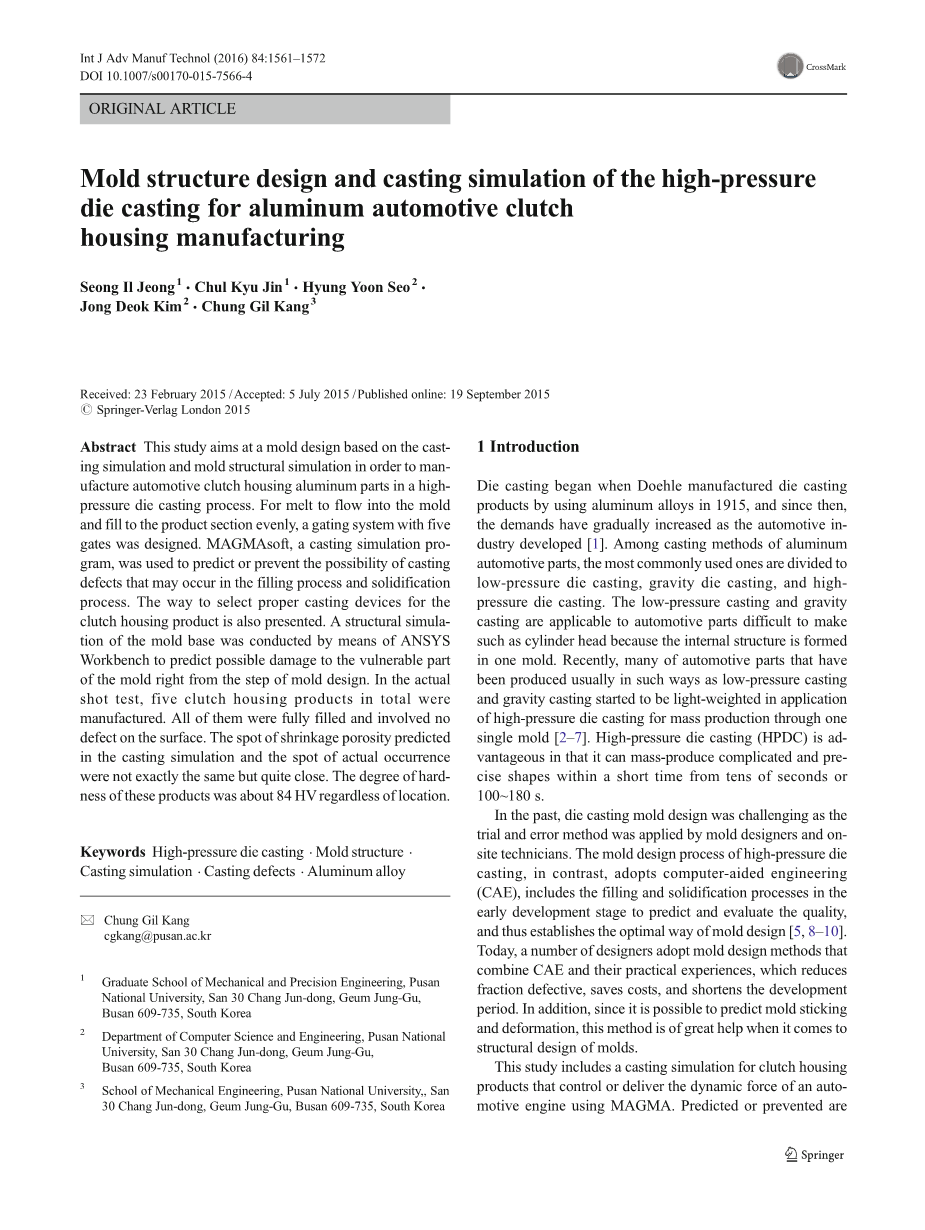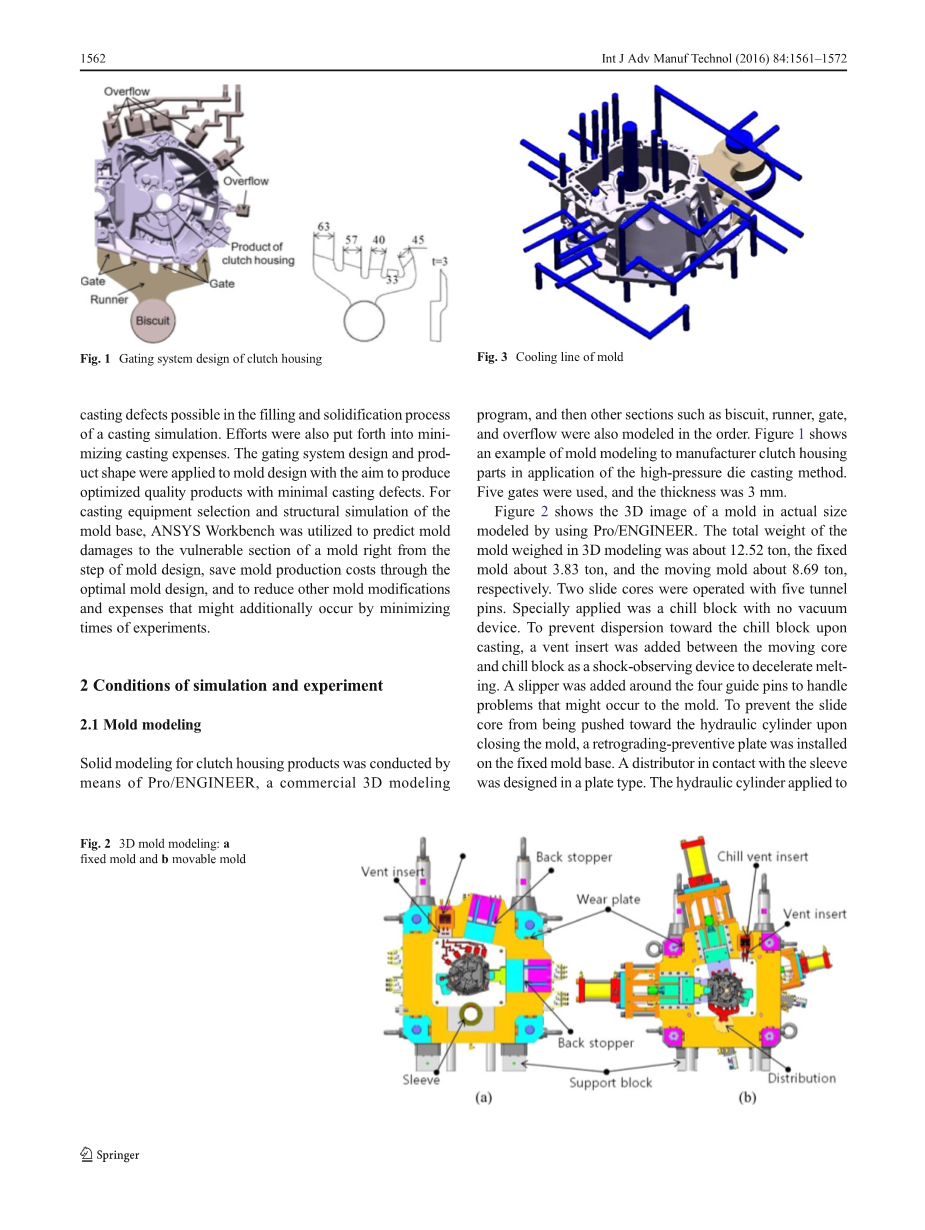

英语原文共 12 页,剩余内容已隐藏,支付完成后下载完整资料
。DOI 10.1007/s00170-015-7566-4
ORIGINAL ARTICLE
Mold structure design and casting simulation of the high-pressure die casting for aluminum automotive clutch
housing manufacturing
Seong Il Jeong1 amp; Chul Kyu Jin1 amp; Hyung Yoon Seo 2 amp;
Jong Deok Kim 2 amp; Chung Gil Kang3
Received: 23 February 2015 / Accepted: 5 July 2015 / Published online: 19 September 2015
# Springer-Verlag London 2015
Abstract This study aims at a mold design based on the cast- ing simulation and mold structural simulation in order to man- ufacture automotive clutch housing aluminum parts in a high- pressure die casting process. For melt to flow into the mold and fill to the product section evenly, a gating system with five gates was designed. MAGMAsoft, a casting simulation pro- gram, was used to predict or prevent the possibility of casting defects that may occur in the filling process and solidification process. The way to select proper casting devices for the clutch housing product is also presented. A structural simula- tion of the mold base was conducted by means of ANSYS Workbench to predict possible damage to the vulnerable part of the mold right from the step of mold design. In the actual shot test, five clutch housing products in total were manufactured. All of them were fully filled and involved no defect on the surface. The spot of shrinkage porosity predicted in the casting simulation and the spot of actual occurrence were not exactly the same but quite close. The degree of hard- ness of these products was about 84 HV regardless of location.
Keywords High-pressure die casting . Mold structure . Casting simulation . Casting defects . Aluminum alloy
Introduction
Die casting began when Doehle manufactured die casting products by using aluminum alloys in 1915, and since then, the demands have gradually increased as the automotive in- dustry developed [1]. Among casting methods of aluminum automotive parts, the most commonly used ones are divided to low-pressure die casting, gravity die casting, and high- pressure die casting. The low-pressure casting and gravity casting are applicable to automotive parts difficult to make such as cylinder head because the internal structure is formed in one mold. Recently, many of automotive parts that have been produced usually in such ways as low-pressure casting and gravity casting started to be light-weighted in application of high-pressure die casting for mass production through one single mold [2–7]. High-pressure die casting (HPDC) is ad- vantageous in that it can mass-produce complicated and pre- cise shapes within a short time from tens of seconds or 100~180 s.
In the past, die casting mold design was challenging as the trial and error method was applied by mold designers and on- site technicians. The mold design process of high-pressure die casting, in contrast, adopts computer-aided engineering
(CAE), includes the filling and solidification processes in the
* Chung Gil Kang cgkang@pusan.ac.kr
1 Graduate School of Mechanical and Precision Engineering, Pusan National University, San 30 Chang Jun-dong, Geum Jung-Gu, Busan 609-735, South Korea
2 Department of Computer Science and Engineering, Pusan National University, San 30 Chang Jun-dong, Geum Jung-Gu,
Busan 609-735, South Korea
3 School of Mechanical Engineering, Pusan National University,, San 30 Chang Jun-dong, Geum Jung-Gu, Busan 609-735, South Korea
early development stage to predict and evaluate the quality, and thus establishes the optimal way of mold design [5, 8–10]. Today, a number of designers adopt mold design methods that combine CAE and their practical experiences, which reduces fraction defective, saves costs, and shortens the development period. In addition, since it is possible to predict mold sticking and deformation, this method is of great help when it comes to structural design of molds.
This study includes a casting simulation for clutch housing products that control or deliver the dynamic force of an auto- motive engine using MAGMA. Predicted or prevented are
Fig. 1 Gating system design of clutch housing
Fig. 3 Cooling line of mold
casting defects possible in the filling and solidification process of a casting simulation. Efforts were also put forth into mini- mizing casting expenses. The gating system design and prod- uct shape were applied to mold design with the aim to produce optimized quality products with minimal casting defects. For casting equipment selection and structural simulation of the mold base, ANSYS Workbench was utilized to predict mold damages to the vulnerable section of a mold right from the step of mold design, save mold production costs through the optimal mold design, and to reduce other mold modifications and expenses that might additionally occur by minimizing times of experiments.
Conditions of simulation and experiment
-
- Mold modeling
Solid modeling for clutch housing products was conducted by means of Pro/ENGINEER, a commercial 3D modeling
program, and then other sections such as biscuit, runner, gate, and overflow were also modeled in the order. Figure 1 shows an example of mold modeling to manufacturer clutch housing parts in application of the high-pressure die casting method. Five gates were used, and the thickness was 3 mm.
Figure 2 shows the 3D image of a mold in actual size modeled by using Pro/ENGINEER. The total
剩余内容已隐藏,支付完成后下载完整资料
资料编号:[236986],资料为PDF文档或Word文档,PDF文档可免费转换为Word


